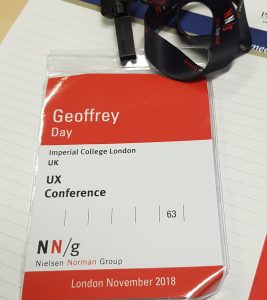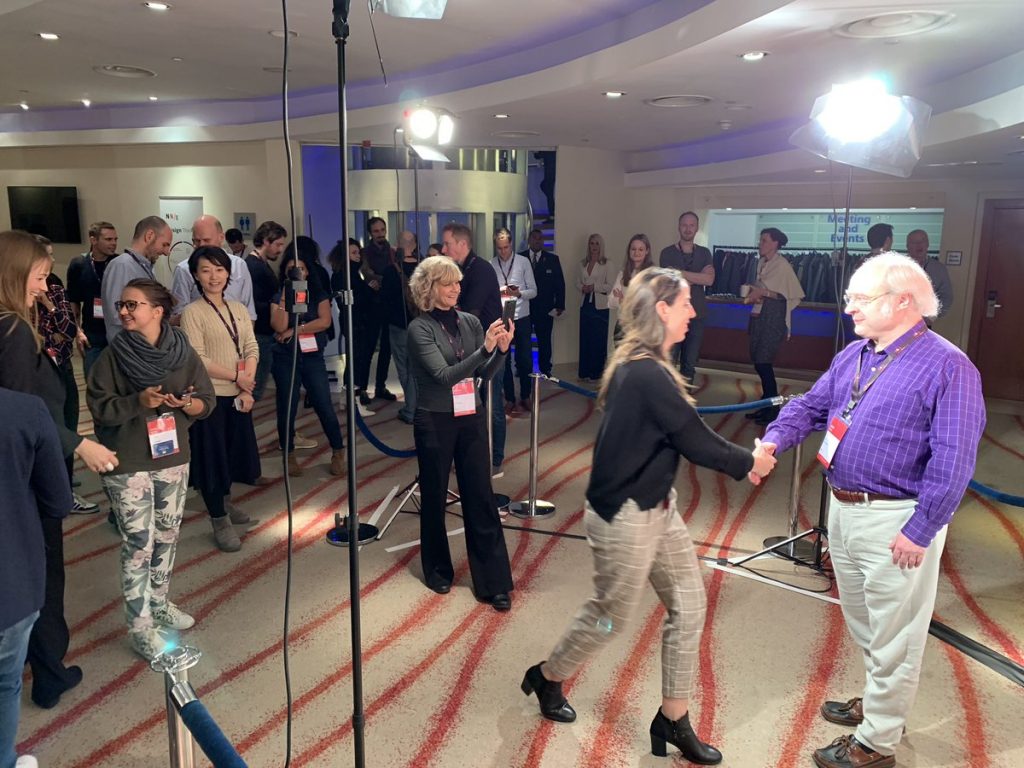A day at the UX Conference in London
 Last week, I attended the UX (User Experience) Conference in London. The conference brought together people from different industries across Europe, all with a shared interest in user experience.
Last week, I attended the UX (User Experience) Conference in London. The conference brought together people from different industries across Europe, all with a shared interest in user experience.
There were the usual networking opportunities, but the main focus of the conference was the wide range of training courses covering topics like:
- Managing UX strategy
- Information Architecture
- Content strategy
- Customer journey mapping
- User testing
- Writing for the web
The conference was hosted by the Nielsen Norman Group (NN/g), co-founded by UX guru Jakob Nielsen. Unfortunately I didn’t get to see Jakob this time, having met him when I attended in 2016.

Writing compelling digital copy session
This year I attended the Writing Compelling Digital Copy course. This was useful in reaffirming some of the practices I do in my role here at Imperial. It also made me think about some aspects in a different way.
With the course still fresh in my mind, I thought I would share a few top tips for writing digital copy.
7 top tips for writing great digital copy
Tip 1: Before you start writing, always answer the following:
- Who is your audience?
- Why are you writing this document?
- How will your reader use this information?
- How should you present the information?
- How are you going to measure success?
Tip 2: Write for how your audiences use the web
When people use the web they are satisficers. Don’t worry if you haven’t heard that word before, it was new to me too! It means that people will do just enough to get what they need from your web pages; they will scan and not read you pages.
“On the average webpage, users have time to read at most 28% of the words during an average visit; 20% is more likely.”
Jakob Nielsen
We can’t change this behaviour, so to help them out we need to write in a clear and concise way. Breaking up the content into chunks with descriptive headings is a good way to start.
There are some great tips for some of these techniques in our top tips section of the web guide.
Tip 3: Choose your tone and wording wisely
If it’s rude to say it in person, it’s rude to say it in copy.
Tip 4: Speak the language of your audience
Remember, you are not writing for yourself. Use clear plain language that your audiences will understand. Improving content for lower-literacy users will benefit everyone. If you make people think or remember too much, you are making them work too hard!
One great quote from the course was:
“This is TOO easy to understand.”
Nobody, ever
Tip 5: Test how easy your content is to read
There are some great tools that can tell you the reading level of your content and some them are free. Read more about this on my post: Useful tools for content audits (see Readability scoring).
Tip 6: Avoid vague modifiers
These are those fluffy phrases that don’t add much to your copy. They include things like:
- “world-leading”
- “The best [service/product]”
- “Life-changing”
Tip 7: Put the most important content first
Sounds obvious, but people typically concentrate on the first couple of paragraphs of your pages and within those paragraphs only the first few sentences and words. You are actually doing that now as you skim read this post! This means you should always try to front-load your important information as much as possible. That way, your audiences are less likely to miss important information.
Want to improve your writing skills for the web?
There is a fantastic Writing for the web course open to all Imperial staff members. The course covers a lot of the things I mention in this post and much more. I strongly recommend.
I would also recommend attending the next NN/g UX conference in London – March-April 2019.
Further reading
- More top tips in the web guide
- Legibility, Readability, and Comprehension by Jakob Nielsen
- Inverted Pyramid: Writing for Comprehension by Amy Schade
- Reading Content on Mobile Devices by Kate Meyer
- F-Shaped Pattern of Reading on the Web: Misunderstood, But Still Relevant by Kara Pernice
- Writing Digital Copy for Specialists vs. General Audiences by Kate Meyer (video)
- Plain Language Is for Everyone, Even Experts by Hoa Loranger
- How Chunking Helps Content Processing by Kate Meyer
- ‘Learn More’ Links: You Can Do Better by Katie Sherwin
Hey there! I’m at work browsing your blog from my
new apple iphone! Just wanted to say I love reading your blog and look forward
to all your posts! Carry on the excellent work!